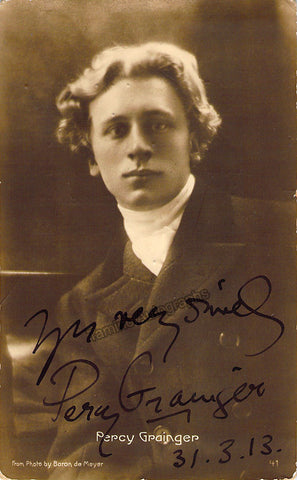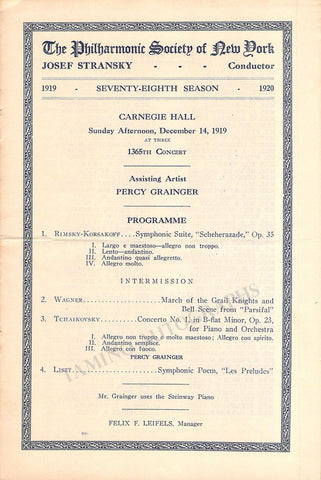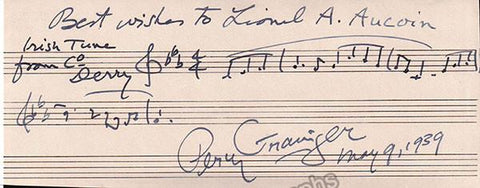Percy Grainger – The Greatest Pianist and Champion of Folk Music May 14 2021
Australian-born pianist and composer-arranger Percy Grainger is often credited with helping to revive interest in British folk music in the early 20th century. His work and his personal life were colourful, leaving behind a legacy that people continue to discuss. Explore the life of Percy Grainger to gain more insight into this unique composer.
PERCY GRAINGER WAS A PIANO PRODIGY
Born George Percy Grainger on 8th July 1882 in a suburb of Melbourne, Australia, he was the son of an English-born father and the daughter of an Adelaide hotelier.
His father was John Harry Grainger (1854-1917), an English immigrant who arrived in Australia in 1877 and an accomplished architect and civil engineer. His mother, Rose Annie Aldridge, was a self-taught expert on many topics and chose to supervise Percy’s education at home.
The family was relatively well-off and lived a comfortable lifestyle. However, Grainger’s father was also a womaniser that had fathered a child with another woman before departing for Australia.
[CLICKABLE IMAGE] Percy Grainger in his youth - a photo signed by him, inscribed to pianist Harold Flammer with a 4-bar music quote from an unknown march.
The parents stayed together until 1890 when John Grainger left for medical treatment in Australia. This allowed Rose to devote even more of her attention to Percy’s studies, including literature and music. Percy Grainger’s formal schooling comprised three months in total; he was bullied by his classmates for his eccentricities.
From an early age, George Percy Grainger was fascinated with the Nordic culture. He was also a talented artist and pianist. Some of his early tutors believed he was destined for a career in the arts instead of music.
However, the piano was his focus.
At the age of 10, his mother arranged for the leading piano teacher in Melbourne, Louis Pabst, to provide piano lessons, and improve his piano technique. A year later, George Percy Grainger composed his first song “A Birthday Gift to Mother”.
In 1894, Grainger performed his first public concert at Melbourne’s Masonic Hall. Louis Pabst departed for Germany that same year and was replaced by Adelaide Burkett.
Burkett arranged additional appearances at larger venues. The size of the major concert venues initially scared young Percy Grainger. He was only 12 years old when he played at Melbourne’s Royal Exhibition Building. Despite his nerves, he received a positive response from critics and the Australian musical public, and it was the start of a long and innovative career as a concert performer.
William Laver, head of piano studies at Melbourne’s Conservatorium of Music, suggested that Percy Grainger’s studies should continue in Frankfurt, at the Hoch Conservatory. Although Percy Grainger never returned permanently, he considered himself an Australian born composer to the core, and was fiercely patriotic.
GRAINGER TRAVELS TO GERMANY TO STUDY PIANO
On 29th May 1895, mother and son moved to Frankfurt so that Percy Grainger could study at Hoch Conservatory. The conservatory’s reputation as a centre of piano excellence was enhanced by the fact that Clara Schumann had been head of piano studies until 1892.
Grainger’s mother, Rose, started working as an English teacher. John Grainger remained in Australia as chief architect to the Western Australian Department of Public Works, but he sent money to help support Rose and Percy.
[CLICKABLE IMAGE] A young Percy Grainger - Signed postcard 1913
Grainger adapted well to the new school, other than some difficulties with his first composition teacher. He dropped out of the composition classes, but the conservatory didn’t provide his only composition teacher, and he also studied privately with an amateur composer named Karl Klimsch.
Klimsch was a folk music composer and a major influence on Grainger’s composition style. He also encouraged Grainger to form the Frankfurt Group with several fellow students. The group aimed to preserve British and Scandinavian folk music and protect them from modern European influences and standard European music. The Frankfurt Group included Roger Quilter, who would go on to become a particularly adept English song composer.
Grainger soon transitioned away from replicating the styles of Mozart and Handel, writing very much his own compositions. He began developing unique orchestral pieces, including several original compositions designed to accompany the poetry of Rudyard Kipling.
Grainger spent a little over five years at Hoch Conservatory, honing his craft until he believed he could financially support himself and Rose. He decided he would start his professional career in London and moved to the UK in 1901.
John Bird, Grainger’s biographer, notes that during his years in Frankfurt, Percy Grainger had developed sexual appetites that were “distinctly abnormal”, including a fascination with punishment and pain.
GRAINGER QUICKLY ESTABLISHES HIMSELF IN LONDON
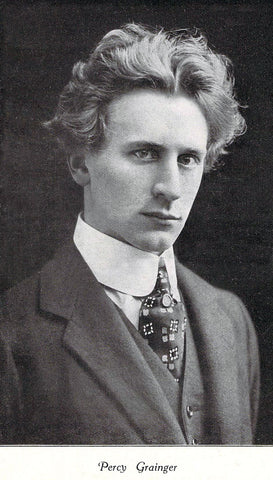
It did not take long for Percy Grainger to start making a living in London. He was a charming young man and talented pianist, allowing him to find work as a society pianist playing private concerts in the homes of wealthy patrons.
As Grainger made the rounds of high society, he became acquainted with Lilith Lowrey. Lowrey was a London socialist and about two decades older than Grainger. However, the two soon established an intimate relationship and Lowrey supplied Grainger with access to more wealthy contacts.
The year of 1902 was a busy year for Grainger. He played his first piano concerto with an orchestra, performing Tchaikovsky’s first with the Bath Pump Room Orchestra. He also toured Britain with Italian-born opera singer Adelina Patti.
Compositions that date from this early period include Percy Grainger’s first mature orchestral pieces. He also worked on Marching Song of Democracy, a Walt Whitman setting, and Grainger embarked on a variety of experimental works.
PRESERVING ORIGINAL FOLK MELODIES
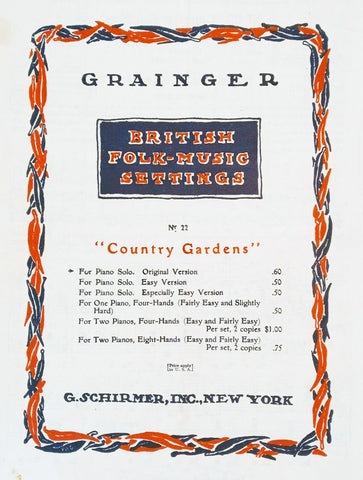
In 1905, Percy Grainger began pursuing a longtime ambition of preserving folk songs and folk music. His renewed interest in collecting songs came after attending a lecture given by folk song historian Lucy Broadwood. He spent five years gathering and transcribing original music carried down through the generations.
[IMAGE] Percy Grainger - British Folk Songs Score
Grainger eventually collected over 300 songs during his travels. Along with transcribing the music, he started recording it. Grainger was one of the first music collectors to capture live music using a phonograph. He recorded 200 phonograph cylinders of performances of folk songs and folk dance tunes from native folk musicians.
Grainger’s friendship with Edvard Grieg began in 1906, after an introduction at the London home of a financier. Grainger had an appreciation of Grieg’s work, and included his piano concerto in his repertoire. Unfortunately, their friendship was cut short by Grieg’s sudden death in 1907. However, its impact on Grainger was such that he championed Grieg’s music for the rest of his life.
Another Australasian tour with contralto Ada Crossley included collecting cylinders of Māori and Polynesian folk music. Compositions from this period include Mock Morris, and Molly on the Shore, not to mention obtaining the tune of Country Gardens from Cecil Sharp - a composition idea that wouldn’t appear for a decade.
WORLD WAR LEADS GRAINGER TO ANOTHER COUNTRY
By 1911, Grainger had spent about a decade as a professional pianist. He was happy with his stature in the music world and ready to start publishing his original compositions. He also adopted the professional name Percy Aldridge Grainger.
The following year, he performed a series of concerts to showcase his original compositions. Grainger’s performance at London’s Queen’s Hall in March 1912 included a band of 30 guitarists and mandolin players for the performance of “Fathers and Daughters”.
[CLICKABLE IMAGE] Concert program for a recital of Percy Grainger in Amsterdam, The Netherlands, 1914.
Everything was going well for Percy Grainger until the start of World War I. As Britain prepared to enter the war, Grainger moved across the seas to the United States. Grainger’s contemporaries and critics considered him a coward for leaving.
At the time, Grainger told the press that he wanted to leave for America to give his mother a change of scenery. He later admitted that he left to avoid the possibility of being killed during the war, which would keep him from reaching his goal of becoming Australia’s first noteworthy composer.
Despite leaving England to avoid the war, he eventually enlisted as a bandsman in the United States Army. He played the saxophone in the band but also had frequently played the piano at Red Cross concerts. As an encore, he played “Country Gardens”. The piece quickly became a best-seller in the sheet music industry.
Compositions from this period include the ambitious 18 minute work The Warriors, subtitled, Music to an Imaginary Ballet”. Like many Grainger works, the instrumentation is flexible, but calls for at least three pianos - or, as in one performance, 19 instruments with 30 players. Critics couldn’t decide whether it was magnificent or a catastrophic failure.
Percy Grainger’s first solo recital was at New York’s Aeolian Hall in February 1915, playing Bach, Brahms, Chopin and Handel, and also his own Mock Morris and Colonial Song.
He gave concerts with compatriot Nellie Melba in Boston, and also performed for President Woodrow Wilson. Percy Grainger also signed a contract with Columbia Records.
On 3rd June 1918, Grainger became a naturalised American citizen. The following year, he left the US Army. He was immediately offered a job as the conductor of the Saint Louis Symphony Orchestra. Grainger preferred the freedom of working as a concert pianist and refused the offer.
Grainger continued to perform, giving over 100 concerts a year for the next several years. He also took the time to occasionally teach a music course, including a course on piano techniques that he taught at the Chicago Musical College.
TRAGEDY LEADS GRAINGER BACK TO EUROPE
In April of 1921, Grainger and his mother moved into a house in White Plains, New York. The house became known as the “Percy Grainger Home and Studio” and would serve as Grainger’s home for the rest of his life.
[CLICKABLE IMAGE] Concert program for a performance of Percy Grainger at Carnegie Hall, N.Y., 1919
After moving to White Plains, Rose Grainger’s health gradually deteriorated. The situation grew dire in 1922. She was experiencing delusions and worried that her health may impact her son’s professional career.
Rose also worried about rumours of an incestuous relationship with her son. Lotta Hough, a friend of Rose’s, confronted her over this issue during a final correspondence posted on 29th April 1922.
The following day, Rose wrote a short letter to Percy, asking if he had discussed an “improper love” with Lotta Hough. Shortly after writing the letter, Rose jumped from the 18th floor of an office building in New York City.
Percy Grainger was traumatised by his mother’s suicide. After his mother’s funeral, Grainger left for Europe. He hoped that returning to work would distract him from his grief.
Grainger traveled through Europe collecting and recording Danish folksongs, forging a friendship with the now almost blind Frederick Delius.. By the end of the year, he began a concert tour that included stops in England, Germany, Australia, Norway, and the Netherlands.
Work around this period included not only reworking and re-scoring his own compositions, but arranging those of others with amazing skill. His preoccupation with Nordic culture grew, and he started to develop a form of English which he claimed reflected pre-Conquest language. The content of some of Percy Grainger’s letters to friends led the music historian David Pear to describe Grainger as “at root, a racial bigot of no small order”.
GRAINGER GETS MARRIED AND BECOMES A PROFESSOR
During his travels back and forth between America, Europe, and Australia, Grainger met a Swedish-born artist named Ella Strom. The two grew close over the next several years and married on 9th August 1928. The wedding was held following one of Grainger’s concerts, which ended with the bridal song “To a Nordic Princess”.
[CLICKABLE IMAGE] An autograph music quote signed by Grainger, dated in 1939. This quote has some notes from an Irish tune -a famous arrangement by Percy.
Married life may have led Grainger to settle down a little. Instead of constantly touring, he became more involved in education. He began teaching at various schools and colleges.
In 1931, Grainger accepted a position as Professor of Music at New York University. He disliked the structure of working at the university and devoted his free time to establishing a museum at the University of Melbourne devoted to ethnomusicological research.
Grainger and his wife Ella travelled to Australia in 1933 to supervise the construction of the Grainger Museum. Around this time, Grainger also began sharing his “free-music” theories. The idea of a Grainger Museum had first occurred to him a year or so previously, and he began to collect items which reflected all areas of his life - professional, and deeply personal.
Percy Grainger’s New York lectures formed the basis for his radio talks for the Australian Broadcasting Commission, and were later published as Music: A Commonsense View of All Types.
Grainger had come to believe that scales, rhythms, and traditional musical rules were too constrictive. He also believed that free music would work best without humans, leading him to spend countless hours working on music machines to supersede human interpretation.
WORLD WAR II AND DECLINING HEALTH
At the start of the Second World War, Grainger and Ella moved to Springfield, Missouri, out of fear of an invasion on the east coast. Grainger spent his time playing charity concerts, making a total of 274 appearances during the war.
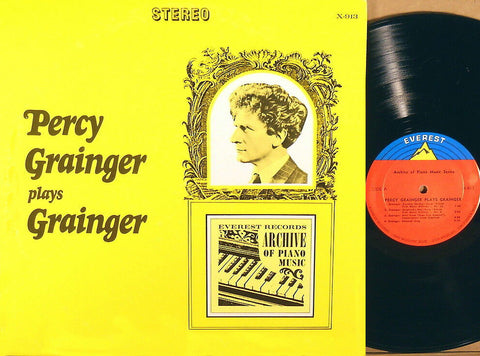
Percy Grainger plays Grainger LP
When the war came to a close, Grainger was exhausted and began to believe that his career was a failure. He refused the Chair of Music at Adelaide University, writing “If I were 40 years younger, and not so crushed by defeat in every branch of music I have essayed, I am sure I would have welcomed such a chance.”
1948 saw him appear at the Proms in London, playing the solo piano part in his Suite on Danish Folksongs. Later in the season, he prommed for a performance of Delius’ Brigg Fair, developed from Grainger’s own setting of the folk song. His friends - Quilter among them - started to die, and in 1953, Grainger was operated on for stomach cancer, something he would suffer from for the rest of his life.
By 1950, Percy Grainger had stopped composing, rarely performed, and focused on building free-music machines with physicist Burnett Cross, with musical instruments including the adapted pianola, and the Estes-Reed Tone-Tool, a kind of giant harmonica.
He gave his last concert at Carnegie Hall in 1954, and was recognised by the King of Norway for his championing of Grieg’s works. however, Grainger was bitter, stating of his own music “all my compositional life I have been a leader without followers.”
In 1955, he visited Australia for the final time, organising exhibits for the Grainger Museum, and snubbing the idea of a Grainger Festival put forward by the Australian Broadcasting Commission, as he felt his homeland had snubbed him and his own uniquely Australian music.
GRAINGER'S LAST YEARS
By 1957, his health - physical and cognitive - was in decline. He continued to make visits to Britain, playing Handel in the Strand for the BBC Concert Hour, and in 1958 meeting Benjamin Britten and planning to visit the Aldeburgh Festival in 1959 - something that never happened due to his illness.
Percy Grainger’s last public concert performance was at Dartmouth College in New Hampshire, although his waning concentration affected his conducting to the point of “fiasco” in his words.
Grainger died in White Plains Hospital on 20th February 1961, and was buried in the fancy vault in West Terrace Cemetery, alongside his mother’s ashes.
His rejection of conventional forms and unique imagination make Percy Grainger’s music instantly recognisable, and Grainger’s life an object of curiosity and debate over 60 years after his death.
SEE ALSO:
- Grainger, Percy - Large Signed Photograph with Music Quote
- Pianists Autographs & Memorabilia
- Grainger, Percy - Concert Program Amsterdam 1934
- Pianists Autographs & Memorabilia
- Concert Programs Signed by Pianists
RELATED BLOG ARTICLES:
- Famous Pianists: The Top 18 Classical Pianists of All Time
- William Kapell: Honest American Pianist of All Time
- Cecile Chaminade: French Pianist and Composer
- Anton Rubinstein: Talented Pianist and Educator
- Ernesto Lecuona: Celebrated Cuban Composer and Pianist
Interested in authentic autographs?




